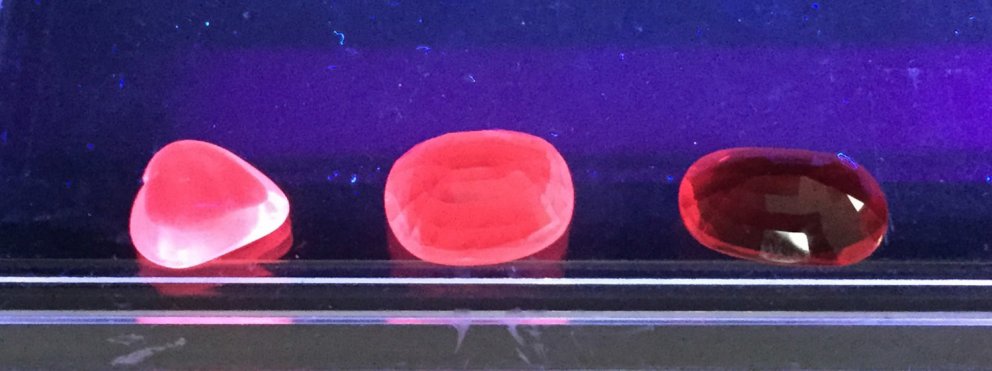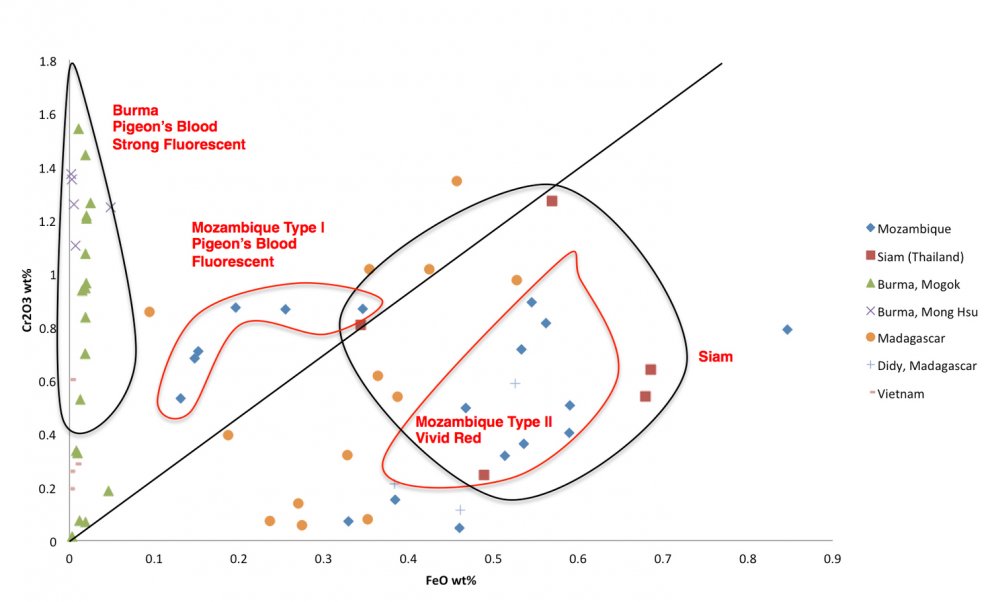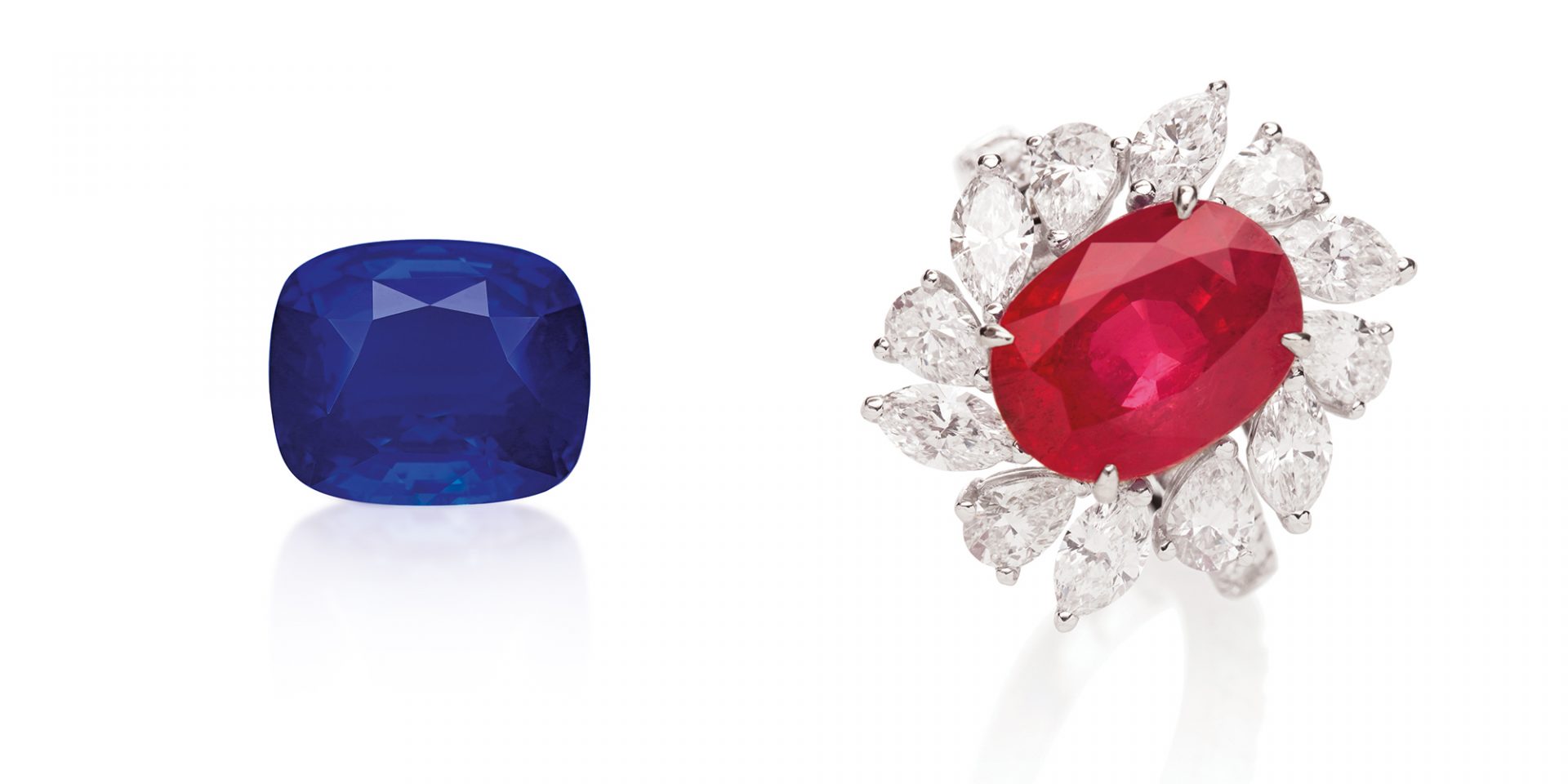The making of an international color standard by GRS: Pigeon's Blood & Royal Blue
Definitions, Retrospective and Future
Definitions
While pigeon’s blood color description was used in the past in the literature for rubies, GRS first made a master set for rubies that defined what pigeon’s blood is in comparison to the intensity of red, namely vivid red was chosen as the color for pigeon’s blood rubies. Vivid red is No. 4 in a scale of 5:
- pinkish-red (1),
- red (2),
- intense red (3),
- vivid red (4)
- deep red (5),
as published on our website since 2001.
GRS' Definition of Pigeon's Blood
Pigeon’s blood color is a vivid red color (high intensity and low tone, e.g. no brown and orange overtones) of a certain group of natural rubies. Rubies are medium to strong fluorescence if exposed to UV (365nm) light (Report samples click here)
Chemically the following compositions are found in pigeon’s blood rubies:
High chromium (Cr) of approx. 0.3 to 0.5 wt-% (or higher) none, very low to medium iron (Fe), while the ratio of Cr/Fe is greater than 1 (individual face-up color and fluorescence corrections are also applied)
Color is graded in day light using master sets as “vivid red” and the color descriptive term GRS-type “pigeon’s blood” is added.
The pigeon’s blood color grade at GRS is independently of the origin applied and the rubies can either be heat-treated or unheated.
The pigeon’s blood label is not granted for:
- beryllium-treated,
- lead-glass-treated
- surface diffusion treated and
- synthetic rubies as well as stones with residues from
- heating e.g. H(b), H(c), H(d).
Traditionally, the gemstone market was dominated by pigeon’s blood rubies from Burma, where of 95% are from the origin of Mong Hsu (dominantly heat-treated) until recently, approx. 5% from Mogok and 1% from Namya, mixed heat-treated and unheated. Unheated Mong Hsu rubies are gemologically very distinctive to separate from Mogok and only a small portion of unheated rubies from Mong Hsu are of pigeon’s blood color due to blue color zones producing purple secondary colors.
In recent years, pigeon’s blood colors have been found from the origins of Vietnam, Tajikistan, Afghanistan and Madagascar and very recently from Mozambique. Roughly 20% of the high value vivid red colors from Mozambique (internal statistic based on stones tested at GRS laboratories) are granted the pigeon’s blood color (stated on the front page of the gemstone report). Although the fluorescence of Mozambique rubies may be slightly weaker than those of Burmese origin, medium to strong fluorescence can be observed with some stones when exposed to UV-light (365nm).

Some vivid red pigeon’s blood colors from Mozambique and Burma cannot be distinguished if graded in daylight. Although most of the Mozambique rubies are heated, a relevant portion of rubies from this origin are unheated and of excellent clarity. In the last 2 years, these rubies have taken the place of rubies from Mogok in the international market, particularly in large sizes between 5 to over 10 carats. The beauty of large sized Mozambique rubies is unparalleled if both color and clarity are taken into consideration.
GRS laboratories possess currently 2 types of master sets with pinkish-red, red, intense red, vivid red and deep red stones. One composed of Burmese rubies and a second set with Mozambican rubies. All GRS locations have one set each (Switzerland, Hong Kong, Bangkok and Sri Lanka).

History: GRS introduces the "Pigeon's Blood" label to the world of gemstone reports in 1996
The concept of pigeon’s blood for rubies, cornflower blue and royal blue for sapphires has been published by GRS in 1996. The pigeonblood.com domain is property of GRS since 2001. The color grades have been intensively used in GRS reports and have moved away from romanticizing literature to become a world standard, now used by almost all of our competitors in the laboratory industry.
Is the term "Pigeon's Blood" used by other labs?
The term has been used by many other labs, often cited today also in auction catalogues as:
May also be called “pigeon’s blood” in the trade Or Poetically referred as “pigeon’s blood” in the trade.
While this wording appears on the main page of the competitors reports, it is often replaced in the short notes of the auction catalogues simply as “pigeon’s blood” color given by other labs or the color grade is given straight forward in the appendix of other gemstone reports (without any waiver). Therefore, in practice our color grading has been widely confirmed internationally and used by other laboratories, although unfortunately used without citation of GRS and sometimes even claiming the introduction of the terms to the market.
Color grade decoupling from origin - a fair concept
Color grades are assigned independently of the stones origin. Origin is a subjective opinion and the results may vary between laboratories. In contrast to origin, the designated color grades can easily be judged by the end consumer (much easier than the origin opinion). Therefore, it is beneficial for the end consumer to decouple color grades from origins. If 2 parameters (origin determination and color grading) get linked, this may lead to more difficulties for the end consumer to evaluate the product (most of the time he cannot judge origin due to lack of highly-sophisticated instruments and reference materials). During the last 2 years, the trade accepted the “pigeon’s blood” color grade for other origins than Burma, for example Mozambique. In the opinion of GRS Laboratories it is considered a fair situation. The end consumer can easily compare Burmese and Mozambican rubies with pigeon’s blood color grade and can make up his own mind about the accuracy by comparing and agreeing or disagreeing. (The vast majority of Burmese rubies with pigeon’s blood colors are assigned to heated stones from Mong Hsu (close to the Thai border), a mining area that is 250 km away from the classic mining area of Mogok).
Availability of "Pigeon's Blood" rubies in the market and future perspectives
The peak Burmese ruby production was between 2002 and 2008, and has now been replaced by Mozambique as the worlds leading ruby producer (Lit. Daily News Baselworld 2015). The pigeon’s blood label creates an excellent successor for Mozambican rubies of same quality. It is already very well recognized in the international market and continued production can be expected with increasing popularity and recognition.
The pigeon’s blood and royal blue color branding is a concept that has managed to de-block the attention from origin and shift the focus of attention towards color and beauty. This concept allows different gem origins to enter the colored stone market in fair competition, minimizing the advantage of ‘branded’ origins such as Burma (Myanmar) and Kashmir (India) to dominate the world of ruby and sapphire market. It gives a fair chance to different gemstone origins to be recognized for their beauty, quality and origin instead of origin-only. This creates an aspect of fair-trade.
We herewith inform the trade that our color grading concepts are in the best interest of the end consumer and the whole gemstone industry. We will do our outermost in research to provide the best possible product and keep you posted on important developments, as they become known to us. Please enjoy our historical retrospective of developing the color standards now accepted all over the world.
Yours Sincerely,
Dr. A. Peretti
Director GRS Laboratories
Rubies and sapphires certified by GRS and their appearance at international auctions - a decade of recognition of the GRS-Type "Pigeon's Blood" and "Royal Blue" color concept
Introduction
Although the terms “Pigeon’s Blood” and “Royal Blue” have historical roots in the literature describing rubies and sapphires, it has also been used for over a decade by GRS laboratories to systematically describe the color of the finest rubies and sapphires in the world. The following chapter is a short review of the literature in which our laboratory reports have been published using these color terms. Our research included mostly auction catalogues. As these objects are auctioned and the result is publically known. This information can be used to establish value of rubies and sapphires as the auction results are published online or can be found in the GRS library. For full references of over 1,000 citations go to our GRS website. A selection of published reports, particularly the reports that were published in auction catalogues with our “pigeon’s blood” and “royal blue” color grading are included in this article (Tab. 02, 03, 04, 05).
First GRS reports references in auction catalogues
The first two ever published reports of GRS appeared in a catalogue by Christie’s in London for its June auction in 1996 used for a sapphire and diamond ring (lot 208, Peretti Gemlab AP-9602007, the previous name of GRS) and for a ruby by Christie’s in London in 1997 (lot 91, GRL9704027, GRL was later renamed GRS). At that time, we used our color terminology for selected gems only. The first high-value unheated Burmese ruby of 22.54 ct size was hammered at Sotheby’s in Geneva, Switzerland in May 2000 (Lot 459) for 1,600,000 CHF without premium (equivalent to 900,000 USD at that time) with a GRS-report (report from 1997, GRL9711067) and was also accompanied with a second report from another laboratory. The first ever published report in a Hong Kong auction appeared in a catalogue from Christie’s in May 2000 (Lot 1620) with a GRS-report (GRS2000-01277) for an “Antique Style Ruby and Diamond Butterfly Clip Brooch”. The first ruby surpassing the 3 million dollar mark was sold with a GRS report (joined with other laboratory reports) at Sotheby’s in Geneva Switzerland (November 2000) for an unheated Burmese Ruby (lot 480, Superb Ruby and Diamond Ring, 32.67ct).
GRS-Type "Pigeon's Blood"
The first GRS certified pigeon’s blood ruby in the million-dollar category was auctioned by Sotheby’s in May 2002 (lot 240, 8.01 ct ruby, GRS report no. 2002-03295). The auction house published our findings as follows:
“The ruby is of Burmese origin, no indication of thermal enhancement and that the colour is vivid red (GRS type “pigeon’s blood”), with the additional rarity comment: Very rare combination of size, colour variety, fine brilliancy and absence of heat enhancement”.
The oldest GRS-type “pigeon’s blood” report published by an auction house appeared in the Sotheby’s auction in Hong Kong (May 2002), where an important pair of Burmese ruby pendant earrings was sold (GRS report no. 2001-11585 was from November 2001). The trend of promoting branded jewelry along with GRS reports was world-wide observed such as in auctions by Bonham’s, Christie’s and Sotheby’s and continues to this day spanning over a period of more than a decade (see tab. 01, 02, 03, 04, 05). GRS-certified rubies with the pigeon’s blood color description mounted in important necklaces did more often appear in the last years in highly valued necklaces at Christie’s between 2007-2012 in Hong Kong (every year between 2007 to 2012, See Tab. 02, 03) and in Hong Kong by Sotheby’s (in 2004, 2008 and 2010, See Tab. 02, 03) but also magnificent rings with GRS certified pigeon’s blood rubies were published in auction catalogues, such as the “Ruby an Diamond Ring by Wallace Chan” (Christie’s, Hong Kong, May 2009, Lot 1724) (See also Tab. 01).
GRS-Type "Pigeon's Blood" - a new world brand initiated by GRS
The continuous appearance of pigeon’s blood rubies in the auction catalogues over a period of 10 years has shown that the public has appreciated this descriptive term for the most valuable rubies in the world. It has been introduced by GRS in 2001, and only since about 2006 we spotted a report using the term “pigeon’s blood” by another recognized laboratory (Christie’s, Hong Kong, November 2006, Lot 2918) and one of the latest international recognized laboratory that adapted our concept was noticed in 2012 (Christie’s Hong Kong, May 2012, Lot 3801). It was however, more frequently used by almost every international recognized laboratories in the last year. It must therefore be assumed, that our terminology has gained worldwide acceptance and appreciation by the end-consumer and has become a world-standard.
Recently, emerging new mines have also produced pigeon’s blood colored rubies. These magnificent unheated pigeon’s blood rubies have already captured the attention of the market and the public will definitively open a new chapter in the history for the most beautiful rubies of the world. They will appear in internationally recognized auction houses with the finest that they have to offer.
GRS and the brands
The first GRS certified rubies set in jewellery by Tiffany and Bulgari appeared at a Sotheby’s auction in Switzerland in 1998. The first GRS certified ruby jewellery by Cartier appeared at an auction in 1999 and the list of brands expanded with time (see Tab. 01). It includes Asprey, Bulgari, Cartier, Chaumet, Currens, Etcetera, Fred Leighton, Fulvio Scavia, Harry Winston, Manuel Bouvier, Mouawad, Marina B., Nardi, Van Cleef & Arpels and Wallace Chan (in alphabetical order, not complete).
GRS reports for heated rubies cited in auction catalogues and the invention of the H(A) and H(B) concept
While most of the published GRS reports were for unheated rubies and sapphires, a limited number of spinels, peridots, alexandrites, garnets and tourmaline, only a small number of reports for heated stones were published in the auction catalogues. They were published in catalogues for auctions in Hong Kong and Melbourne by Sotheby’s and Christie’s (See Tab. 02). The residue grading of GRS was used in the catalogues to describe these rubies with our code abbreviation’s H(a) and H(b) in Hong Kong and New York (e.g. Sotheby’s December 2004, lot 230 and 232, Ruby and Diamond Pendant necklace). The auction catalogue mentioned that the rubies were accompanied by GRS report no. 2004-070559 stating that our report says “the ruby is of Burmese origin; enhanced by heat, minor residues present”. A pair of ruby and diamond ear clips was auctioned in 2003 in Hong Kong with GRS2003-02484 report (Lot 619) stating the finding of our report. The description that is printed on the reverse side of our reports was cited “Enhanced by heat, residues insignificant (indication of very small residues within fissures only)”. This time the full wording was used and not our abbreviation. Heated rubies never gained much attention by the auction houses between 1996 and 2012.
GRS Type "Royal Blue"
Sotheby’s in St. Moritz published the first GRS Report using the color description “royal blue” in February 1998 (GRL9712003). It was a Sri Lankan sapphire ring from Van Cleef & Arpels. GRS was cited describing the stone as “intense royal blue”. The oldest GRS report with GRS-type “Royal Blue” mentioned in an auction catalogue was found in an auction at Christie’s in New York (October 2000, Lot 622, A sapphire and diamond ring, GRS-2000- 04168).
The first GRS-certified royal blue sapphire of magnificent quality that fetched a multimillion-dollar auction result was sold in Geneva, Switzerland (Sotheby’s November 2001, Lot 406). It was an “Exquisite Sapphire and Diamond Ring” sapphire weight, 58.97 ct. The catalogue states the findings of the GRS report No. GRS2001-04395 as “The sapphire is of “Burmese origin”, no indication of thermal enhancement and the special comment: “Extremely rare combination of color variety (“royal blue”), excellent clarity and brilliancy, and absence of heat treatment. The achieved record price must have definitely put the “Royal Blue” label to the attention of the buyers and brands for future important sapphires. Burmese origins are mostly promoted by the auction houses but not exclusively. GRS reports for Sri Lanka, Madagascar, both heated and unheated have been published as well. A selection of sapphires that were labeled as GRS-type “royal blue” is shown in the table 04 and 05. These new sapphire origins are today almost the only source of the world’s most important sapphires. They will make their way to the international auctions as soon as the public understands these facts. These sapphires can also achieve the best “royal blue” color and will dominate the future market place after the Burmese source continuously proves to be exhausted and it has to be seen in the next year after Burma has opened it doors to investors whether the mines can be brought back to production after a long interruption period.
© 2023, GRS GemResearch Swisslab AG

